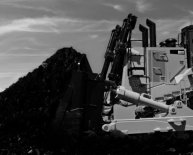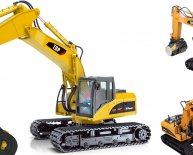
Earth Moving machines
A wheel loader is an earth-moving machine used in construction sites, gravel pits and mining to move blasted rock, soil and gravel. In the presence of a nearby dump truck, the wheel loader is said to be operating in a short loading cycle. This paper concerns the moving of material (soil, gravel and fragmented rock) by a wheel loader in a short loading cycle with more emphasis on the loading step. Due to the complexity of bucket-environment interactions, even three decades of research efforts towards automation of the bucket loading operation have not yet resulted in any fully autonomous system. This paper highlights the key challenges in automation and tele-remote operation of earth-moving machines and provides a survey of different areas of research within the scope of the earth-moving operation. The survey of publications presented in this paper is conducted with an aim to highlight the previous and ongoing research work in this field with an effort to strike a balance between recent and older publications. Another goal of the survey is to identify the research areas in which knowledge essential to automate the earth moving process is lagging behind. The paper concludes by identifying the knowledge gaps to give direction to future research in this field.
Keywords
- Earth-moving;
- Automation;
- Loader;
- Short loading cycle
1. Introduction
Earth-moving machines comprise a large set of industrial machines used in construction, mining, forestry, agriculture, cleaning and many other industries. Such machines generally include a vehicle (i.e., a main body) and a robotic mechanism mounted on the vehicle. Many types of earth-moving machines are available with different combinations of vehicle and robotic mechanisms. The robotic mechanism typically consists of a robotic arm (a combination of links and joints) powered by a hydraulic system and a tool designed for tasks such as loading or excavation of materials. It is often possible to change the tool to adapt to different tasks. Wheel loaders and excavators are two common examples of mobile earth-moving machines.
Wheel loaders are extremely versatile and often used as multi-purpose machines at production sites . Applications for which wheel loaders are used everyday include the transportation of soil, ore, snow, wood-chips and construction material. Wheel loaders have extensive use in the mining industry, where they are used to transport ore in both open-pit mines and underground mines. In underground mines, special types of wheel loaders are used: LHD (Load-Haul-Dump) machines. Fundamentally, LHD machines are the same as wheel loaders except that they are adapted for the low ceilings of underground mines.
Automation of wheel loaders and excavators has been an active area of research over the past three decades . As claimed by Maeda , despite much research in this field, a fully automated system for a mobile earth-moving machine has never been demonstrated. In Hemami and Hassani , the authors conclude that the subject demands more research, together with industrial support, to speed up the process towards successful autonomous loading of bulk material.
In this paper, the focus is on automation and remote control of earth-moving machines such as wheel loaders and LHD machines. The main contributions of the paper are the review and assessment of different approaches for automating the steps involved in short cycle loading and the survey of publications on automation of earth-moving machines. We also provide an in-depth review of different automatic bucket loading strategies and discussion on possible approaches. In the paper, we highlight important knowledge gaps in the areas of automatic loading of fragmented bulk material, wireless communications, and operator experience and performance in tele-remote operation.
We find that automating the complete short loading cycle is not viable in the short to mid-term. Given the identified challenges in full automation of the earth-moving process, we consider semi-automation through assisted tele-remote operation to be an important step to collect experience for further research and development. Reliable wireless communication becomes essential when machines are tele-remotely operated. This paper also gives a brief overview of communication-related challenges and possible solutions.
The difficulty in automating the entire process can be attributed to the fact that it is impossible to accurately model the earth-moving process, especially the interaction between the tool and the environment. The properties of media to be excavated or moved are central to the problem. Examples of different media are snow, soil, gravel, wood chips, fragmented rock, mud, etc. Autonomous excavation of soil is a well-studied problem, and yet fully automated excavators are rare .

















